window GMC YUKON DENALI 2003 Owners Manual
[x] Cancel search | Manufacturer: GMC, Model Year: 2003, Model line: YUKON DENALI, Model: GMC YUKON DENALI 2003Pages: 447, PDF Size: 21.97 MB
Page 2 of 447

The 2003 GMC Yukon DenaIiNukon XL Denali
Owner Manual
Seats and Restraint Systems ........................... 1-1
Front Seats
............................................... 1-3
Rear Seats
............................................... 1-7
Safety Belts
............................................. 1-25
Child Restraints
....................................... 1-48
Air Bag Systems
...................................... 1-72
Restraint System Check
............................ 1-86
Features and Controls ..................................... 2-1
Keys
........................................................ 2-3
Doors and Locks
....................................... 2-8
Windows
................................................. 2-14
Theft-Deterrent Systems
............................ 2-1 6
Starting and Operating Your Vehicle
....... 2-18
Mirrors
.................................................... 2-31
Onstar@
S stem ...................................... 2-36
HomeLink
J Transmitter ............................. 2-38
Storage Areas
......................................... 2-42
Sunroof
.................................................. 2-46
Vehicle Personalization
............................. 2-47
Instrument Panel ............................................. 3-1
Instrument Panel Overview
.......................... 3-4
Warning Lights, Gages and Indicators
......... 3-28
Driver Information Center (DIC)
.................. 3-43
Climate Controls
...................................... 3-1 9
Audio System(s)
....................................... 3-58
Driving Your Vehicle ....................................... 4-1
Your Driving, the Road, and Your Vehicle
..... 4-2
Towing
................................................... 4-44
Service
..................................................... 5-3
Fuel
......................................................... 5-5
Checking Things Under the Hood ............... 5-10
All-Wheel Drive
........................................ 5-46
Rear Axle ............................................... 5-48
Bulb Replacement
.................................... 5-49
Tires
...................................................... 5-55
Appearance Care ..................................... 5-78
Vehicle Identification
................................. 5-86
Electrical System
...................................... 5-87
Capacities and Specifications
..................... 5-96
Normal Maintenance Replacement Parts
...... 5-98
Maintenance Schedule
................................ 6-2
Customer Assistance Information .................... 7-1
Customer Assistance Information
.................. 7-2
Reporting Safety Defects
............................ 7-9
Index ................................................................ 1
Service and Appearance Care .......................... 5-1
Windshield Wiper Blade Replacement
......... 5-54
Maintenance Schedule ..................................... 6-1
Page 6 of 447
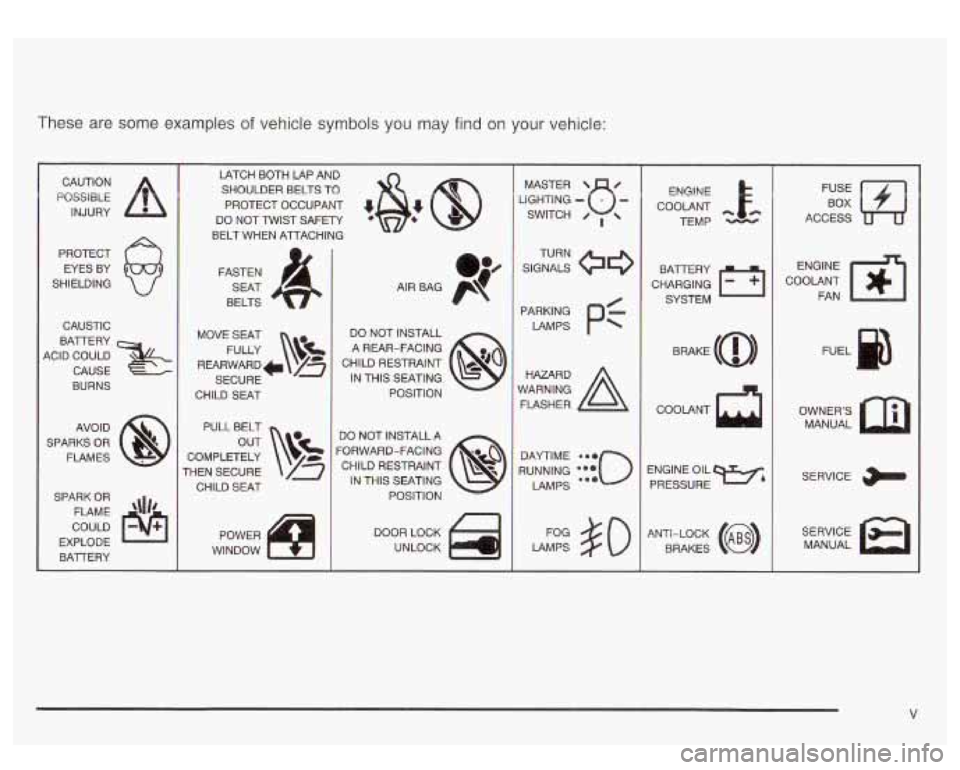
These are some examples of vehicle symbols you may find on your vehicle:
CAUTION
POSSIBLE
INJURY
PROTECT EYES BY
SHIELDING
CAUSTIC
BATTERY
ACID COULD CAUSE
BURNS
AVO ID
SPARKS
OR
FLAMES
SPARK
OR
FLAME '\I/'
COULD
EXPLODE BATTERY LATCH BOTH LAP AND
SHOULDER BELTS TO
PROTECT OCCUPANT
4
DO NOT TWIST SAFETY
BELT WHEN ATTACHING
FASTEN SEAT
BELTS
MOVE SEAT DO NOT INSTALL
A REAR-FACING
CHILD RESTRAINT
SECURE IN THIS SEATING
CHILD SEAT POSITION
FULLY
c REARWARD+ /3
PULL BELT DO NOT INSTALL A
COMPLETELY
THEN SECURE
CHILD SEAT FORWARD-FACING
CHILD RESTRAINT IN THIS SEATING
POSITION
POWER DOOR LOCK
WINDOW UNLOCK LIGHTING
- MASTER SWITCH u- 0 ,
LAMPS #O
ENGINE
COOLANT
-FA TEMP -
CHARGING Fl
BATTERY
SYSTEM
ENGINE OIL PRESSURE
9%77
ANTI-LOCK (@)
BRAKES
FUSE BOX
ACCESS
ENGINE
COOLANT FAN
OWNER'S MANUAL
SERVICE
SERVICE MANUAL
V
Page 48 of 447
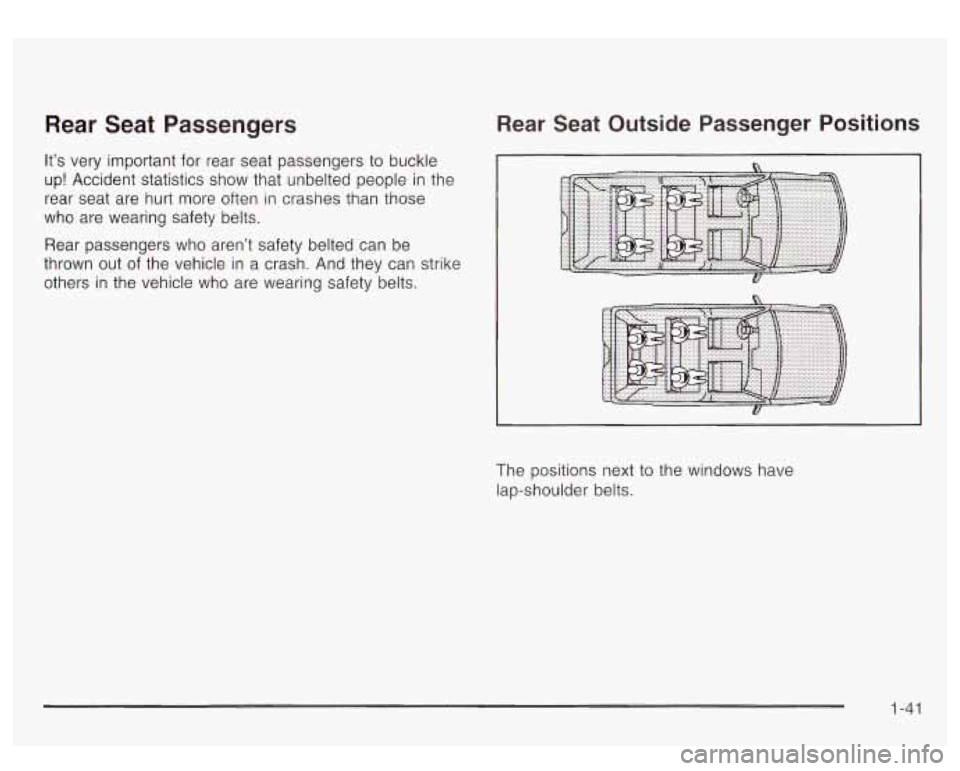
Rear Seat Passengers
It’s very important for rear seat passengers to buckle
up! Accident statistics show that unbelted people in the
rear seat are hurt more
often in crashes than those
who are wearing safety belts.
Rear passengers who aren’t safety belted can be
thrown out of the vehicle in a crash. And they can strike
others in the vehicle who are wearing safety belts.
Rear Seat Outside Passenger Positions
The positions next to the windows have
lap-shoulder belts.
Page 62 of 447
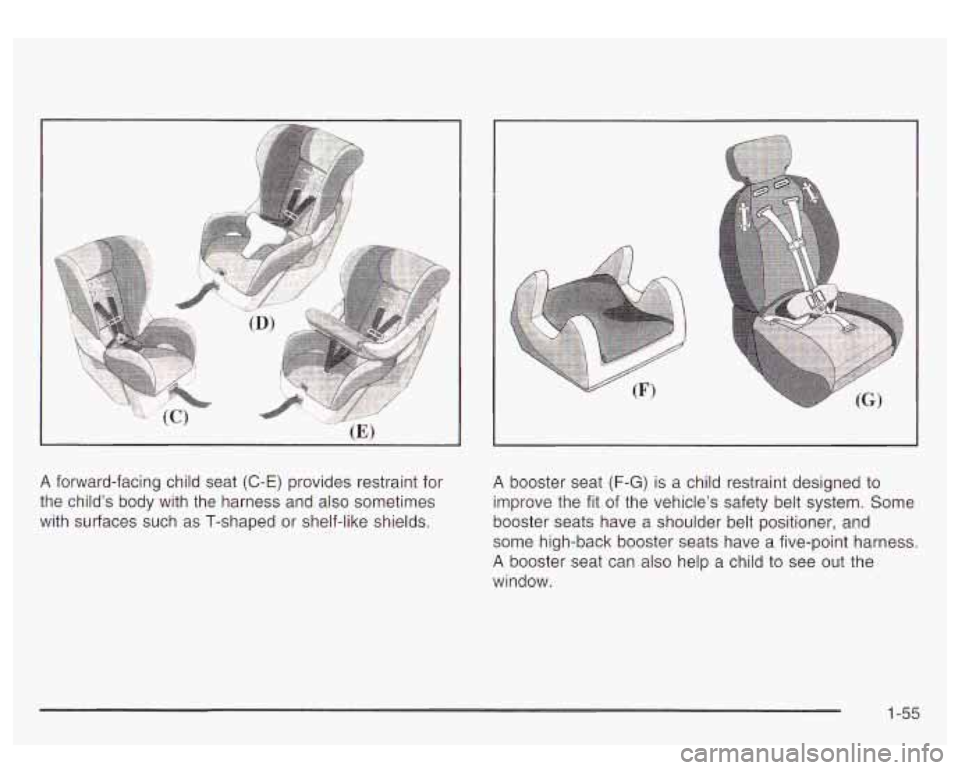
A forward-facing child seat (C-E) provides restraint for
the child’s body with the harness and also sometimes
with surfaces such as T-shaped or shelf-like shields. A booster seat (F-G) is a child restraint designed to
improve the fit of the vehicle’s safety belt system. Some
booster seats have a shoulder belt positioner, and
some high-back booster seats have a five-point harness.
A booster seat can also help a child to see out the
window.
1-55
Page 86 of 447

What Will You See After an Air Bag
Inflates?
After the air bag inflates, it quickly deflates, SG quickly
that some people may not even realize the air bag
inflated. Some components of the air bag module will be
hot for a short time. These components include the
steering wheel hub for the driver’s frontal air bag and the
instrument panel for the right front passenger’s frontal
air bag. For vehicles with side impact air bags, the side
of the seatback closest to the driver’s and/or right
front passenger’s door will be hot. The parts of the bag
that come into contact with you may be warm, but
not too hot
to touch. There will be some smoke and dust
coming from the vents in the deflated air bags. Air
bag inflation doesn’t prevent the driver from seeing or
being able
to steer the vehicle, nor does it stop
people from leaving the vehicle. hen an
E bag inflates, there __ dust in t..-
air. This dust could cause breathing problems
for people with a history of asthma or other breathing trouble.
To avoid this, everyone in
the vehicle should get out as soon as
it is safe
to do
so. If you have breathing problems but
can’t get out of the vehicle after an air bag inflates, then get fresh air by opening
a
window or a door. If you experience breathing problems following an air bag deployment, you
should seek medical attention.
1-79
Page 96 of 447
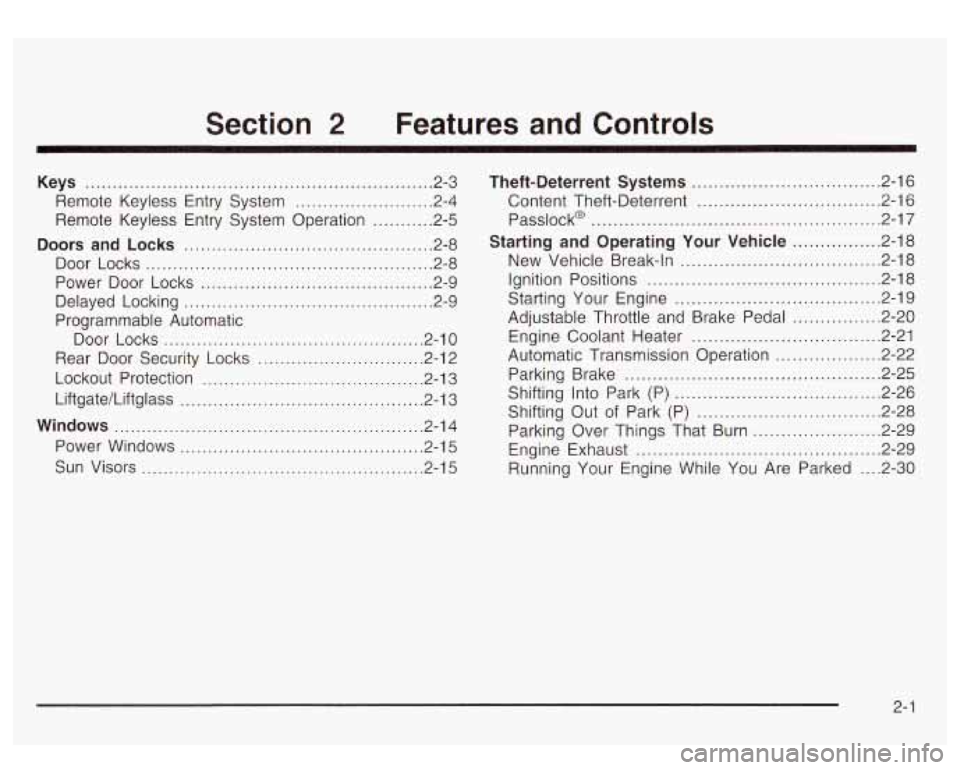
Section 2 Features and Controls
Keys ............................................................... 2.3
Remote Keyless Entry System
......................... 2.4
Remote Keyless Entry System Operation
........... 2.5
Doors and Locks ............................................. 2.8
Door Locks
................................................. 2.8
Power Door Locks
.......... .... ............. 2.9
Delayed Locking
............................................. 2.9
Programmable Automatic
Door Locks
............................................... 2.10
Rear Door Security Locks
.............................. 2.12
Lockout Protection
........................................ 2.13
LiftgateILiftglass
..................................... 2.13
Windows ........................................................ 2.14
Power Windows
............................................ 2.15
Sun Visors
................................................... 2.15
Theft-Deterrent Systems .................................. 2.16
Content Theft-Deterrent
................................. 2.16
Passlock@
.................................................... 2.17
Starting and Operating Your Vehicle ................ 2.18
New Vehicle Break-In
.................................... 2-18
Starting Your Engine
..................................... 2.19
Engine Coolant Heater
.................................. 2.21
Automatic Transmission Operation
................... 2.22
Shifting Into Park (P)
................. , ........ 2.26
Shifting Out of Park (P)
..................... , ........ 2-28
Parking Over Things That Burn
....................... 2-29
Engine Exhaust
............................................ 2.29
Running Your Engine While You Are Parked
.... 2-30
Ignition Positions
.......................................... 2.18
Adjustable Throttle and Brake Pedal
............... -2-20
Parking Brake
.............................. ..... 2.25
2-
1
Page 98 of 447
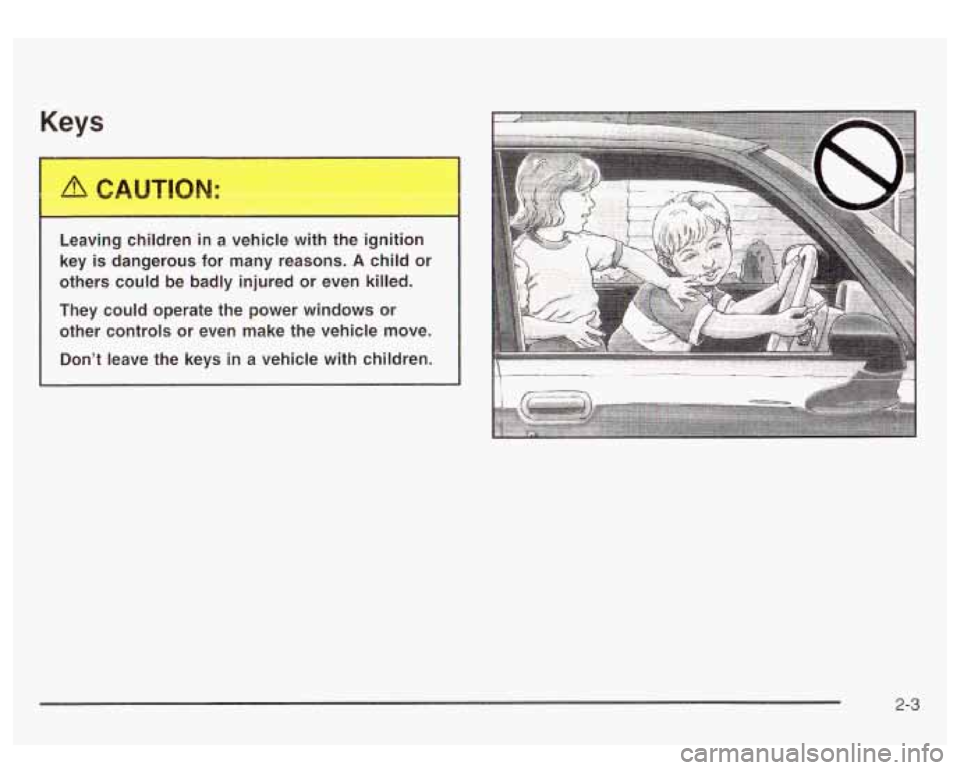
Keys
key is dangerous for many reasons. A child or
others could be badly injured or even killed.
They could operate the power windows or
other controls or even make the vehicle move.
Don't leave the keys in a vehicle with children.
2-3
Page 108 of 447
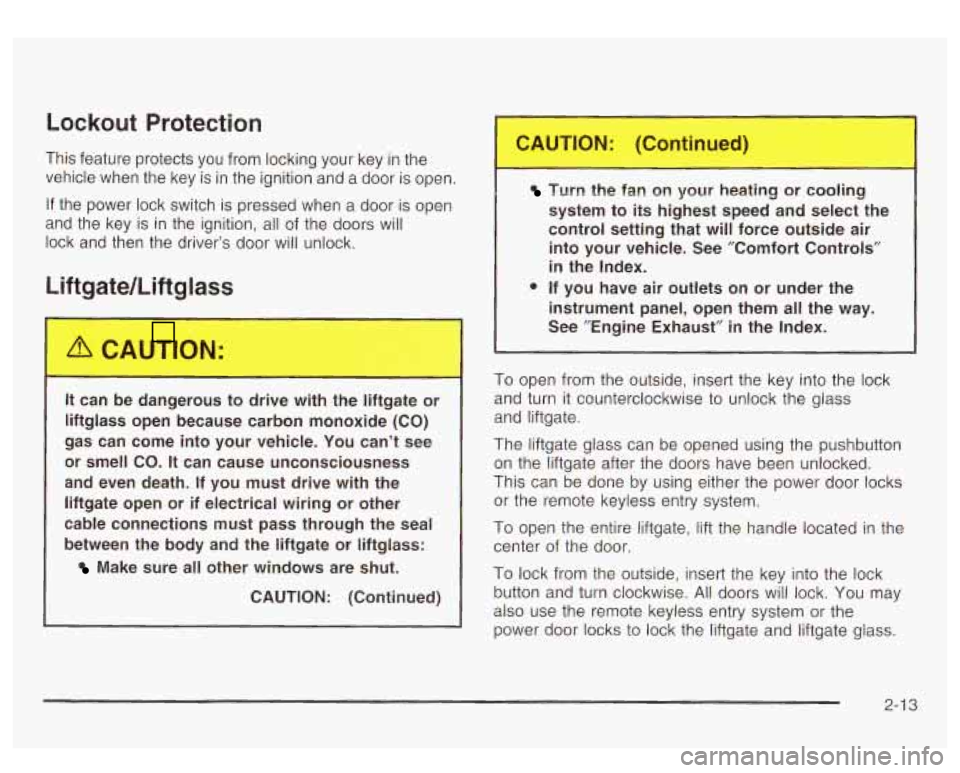
Lockout Protection
This feature protects you from locking your key in the
vehicle when the key is in the ignition and a door is open.
If the power lock switch is pressed when a door is open
and the key is in the ignition, all
of the doors will
lock and then the driver’s door will unlock.
Liftgate/Liftglass
It can be dangerous to drive with the liftgab- or
liftglass open because carbon monoxide (CO)
gas can come into your vehicle. You can’t see
or smell CO.
It can cause unconsciousness
and even death. If you must drive with the
liftgate open or
if electrical wiring or other
cable connections must pass through the seal
between the body and the liftgate or liftglass:
Make sure all other windows are shut.
CAUTION: (Continued)
7 ill :: ;he fan your hez ... jg or cooling
system to its highest speed and select the
control setting that will force outside air
into your vehicle. See ”Comfort Controls”
in the Index.
@ If you have air outlets on or under the
instrument panel, open them all the way.
See ”Engine Exhaust” in the Index.
To open from the outside, insert the key into the lock
and turn it counterclockwise
to unlock the glass
and liftgate.
The liftgate glass can be opened using the pushbutton
on the liftgate after the doors have been unlocked.
This can be done by using either the power door locks or the remote keyless entry system.
To open the entire liftgate,
lift the handle located in the
center of the door.
To lock from the outside, insert the key into the lock
button and turn clockwise.
All doors will lock. You may
also use the remote keyless entry system or the
power door locks to lock the liftgate and liftgate glass.
2-1 3
Page 109 of 447

Windows
m
Le: ng ch ren in a vehicle with the wind-.s
closed is dangerous.
A child can be overcome
by the extreme heat and can suffer permanent
injuries
or even death from heat stroke. Never
leave a child alone in a vehicle, especially with
the windows closed in warm or hot weather.
2-1 4
Page 110 of 447
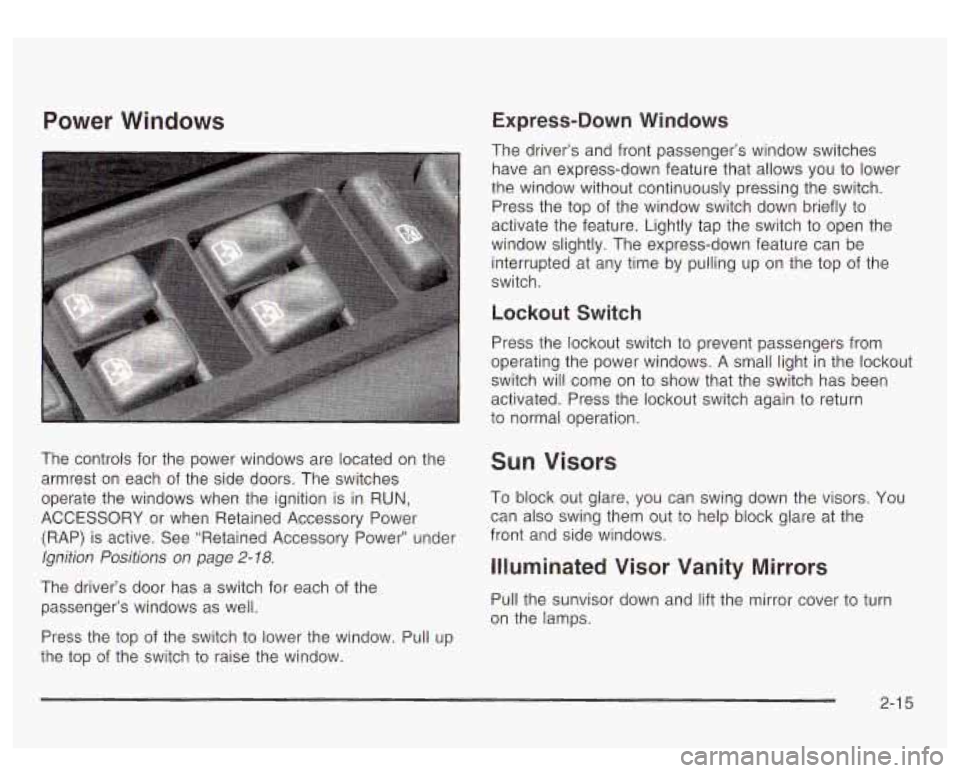
Power Windows
The controls for the power windows are located on the
armrest on each of the side doors. The switches
operate the windows when the ignition is in
RUN,
ACCESSORY or when Retained Accessory Power
(RAP) is active. See “Retained Accessory Power” under
Ignition Positions
on page 2- 18.
The driver’s door has a switch for each of the
passenger’s windows as well.
Press the top of the switch to lower the window. Pull up
the top of the switch to raise the window.
Express-Down Windows
The driver’s and front passenger’s window switches
have an express-down feature that allows you to lower
the window without continuously pressing the switch.
Press the top of the window switch down briefly to
activate the feature. Lightly tap the switch to open the
window slightly. The express-down feature can be
interrupted at any time by pulling up on the top of the
switch.
Lockout Switch
Press the lockout switch to prevent passengers from
operating the power windows. A small light in the lockout
switch will come on to show that the switch has been
activated. Press the lockout switch again to return
to normal operation.
Sun Visors
To block out glare, you can swing down the visors. You
can also swing them out to help block glare at the
front and side windows.
Illuminated Visor Vanity Mirrors
Pull the sunvisor down and lift the mirror cover to turn
on the lamps.
2-1 5